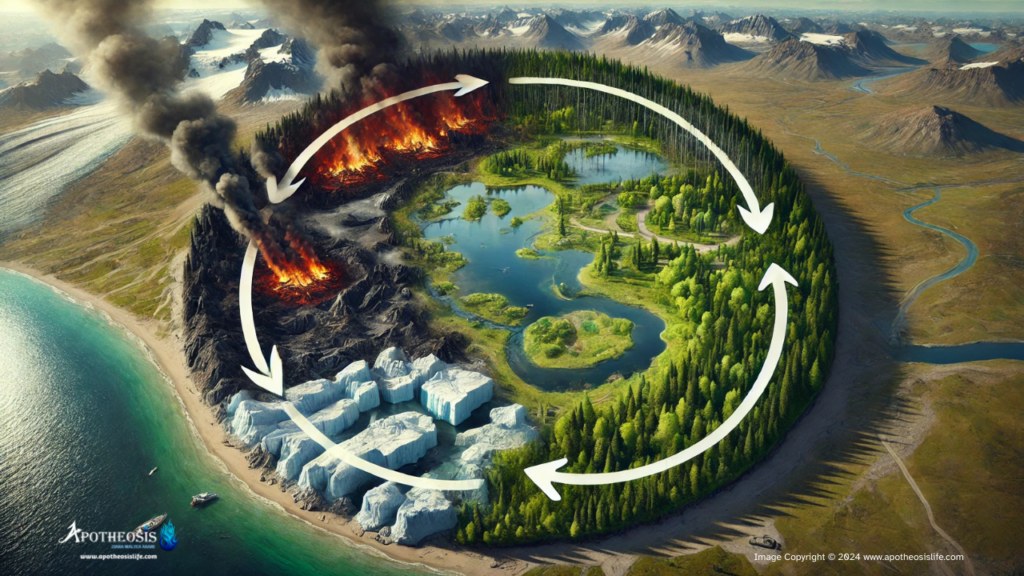Climate Feedback Loops are powerful natural processes that can accelerate global warming and magnify the impacts of climate change. They occur when warming triggers effects that intensify the initial warming, creating a self-reinforcing cycle. While some feedback loops can help stabilize the climate, many Climate Feedback Loops are amplifying the effects of human-induced climate change, leading to more extreme weather, rising sea levels, and disrupted ecosystems. Understanding Climate Feedback Loops is crucial for developing effective strategies to mitigate climate change and protect the planet.
What Are Climate Feedback Loops?
A Climate Feedback Loop is a process where a change in the climate system causes secondary effects that either amplify (positive feedback) or diminish (negative feedback) the original change.
Positive Climate Feedback Loops: Enhance the initial effect, leading to more warming.
Negative Climate Feedback Loops: Counteract the initial effect, helping stabilize the climate.
Example: When global temperatures rise, melting ice reduces the Earth’s reflectivity, causing more heat absorption and further warming—a classic positive Climate Feedback Loop.
Key Positive Climate Feedback Loops Driving Warming
Ice-Albedo Feedback Loop
The Ice-Albedo Feedback Loop is a significant positive Climate Feedback Loop. Albedo refers to the reflectivity of a surface. Ice and snow have a high albedo, meaning they reflect most of the sun’s rays back into space. However, as the Earth warms, ice melts, and darker surfaces like ocean water and land are exposed:
Darker surfaces absorb more heat, reducing albedo.
More heat absorption leads to more ice melt, amplifying warming.
Example: In the Arctic, the Ice-Albedo Feedback Loop is accelerating warming, with temperatures rising twice as fast as the global average.
Permafrost Thawing and Greenhouse Gas Release
Permafrost Thawing is a Climate Feedback Loop with global implications. Permafrost is permanently frozen ground in polar regions, storing vast amounts of carbon as organic matter. As permafrost thaws:
Microbes decompose organic matter, releasing carbon dioxide (CO₂) and methane (CH₄)—a potent greenhouse gas.
More greenhouse gases in the atmosphere trap heat, causing further warming.
Example: The release of methane from thawing permafrost in Siberia could significantly accelerate global warming, magnifying Climate Feedback Loops.
Forest Dieback as a Climate Feedback Loop
Forests act as carbon sinks, absorbing CO₂ from the atmosphere. However, climate change can stress forests, leading to wildfires, droughts, and insect infestations:
Dying forests release stored carbon, contributing to higher CO₂ levels.
Increased carbon emissions lead to more warming, triggering further forest dieback, a vicious Climate Feedback Loop.
Example: The Amazon Rainforest, often called the “lungs of the Earth”, is increasingly becoming a carbon source rather than a carbon sink due to deforestation and climate stress, exacerbating Climate Feedback Loops.

Engaging representation of climate feedback loops, showing how melting ice, wildfires, and changing forests contribute to self-reinforcing climate change.
How Positive Climate Feedback Loops Drive Extreme Weather
The amplifying nature of positive Climate Feedback Loops contributes to extreme weather events, including:
More Intense Heatwaves: Higher temperatures lead to drier soils, reducing cooling through evaporation.
Increased Wildfires: Droughts and heat create conditions for larger, more intense wildfires.
Accelerated Sea Level Rise: Melting ice sheets contribute to higher sea levels, increasing the risk of coastal flooding.
Mitigating the Impact of Climate Feedback Loops
To reduce the impact of positive Climate Feedback Loops, global efforts must focus on:
Reducing Greenhouse Gas Emissions: Transitioning to renewable energy, improving energy efficiency, and promoting sustainable practices.
Protecting Natural Carbon Sinks: Conserving forests, wetlands, and oceans to maintain their carbon absorption capacity.
Supporting Adaptation Measures: Developing infrastructure to withstand extreme weather events and improving early warning systems.
Climate Feedback Loopsplay a critical role in shaping the future of the planet. By understanding these processes and implementing effective climate strategies, humanity can help break the cycle of warming, slow down climate change, and create a sustainable future for generations to come. The time to act is now, as each step taken to reduce emissions and protect natural ecosystemsbrings the world closer to a stable and resilient climate.
Details of the Featured Image
Natural elements like melting ice, wildfires, deforestation, and greenhouse gases forming a circular loop, illustrating the self-reinforcing nature of climate change.
Image Copyright © 2024 www.apotheosislife.com
Author
Ziara Walter Akari
© www.apotheosislife.com
